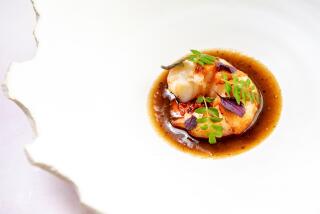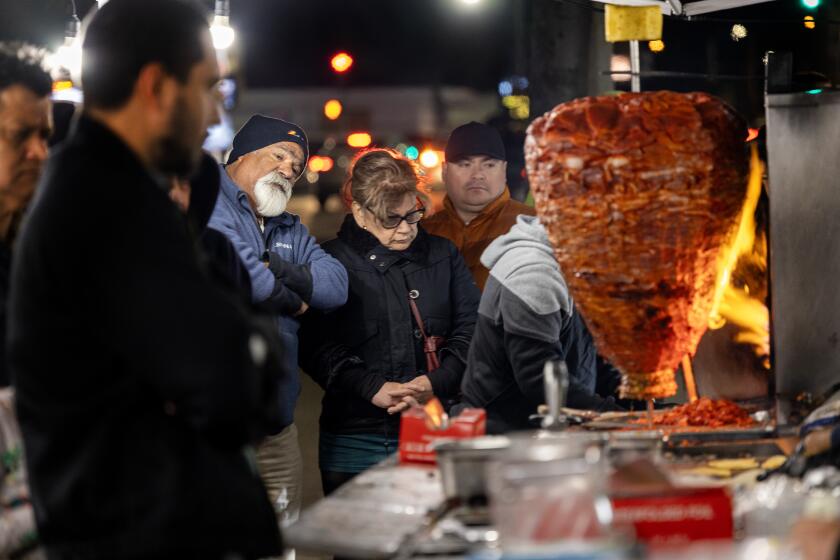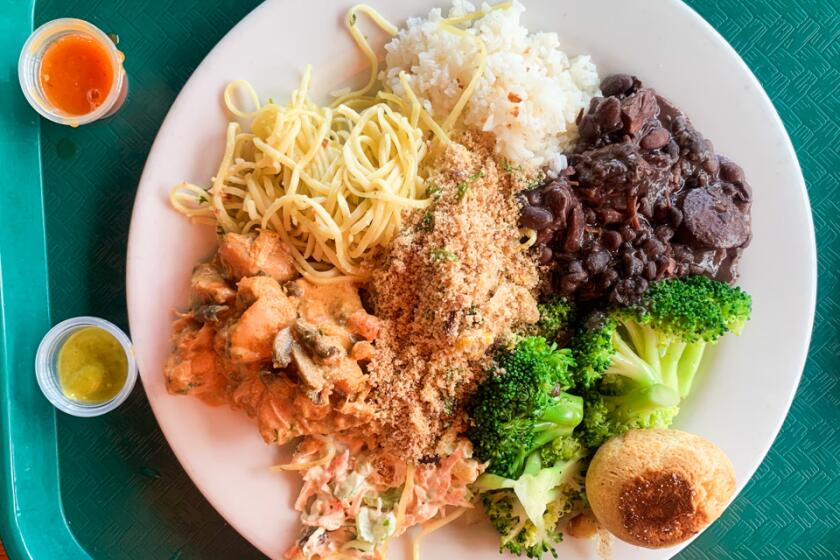Un-Haughty French
Ever since Wolfgang Puck opened a little place called Spago and ushered in the era of chic casual dining, formal restaurants have been struggling to hold their own. Why would anyone want to wrestle with a tie when they can eat foie gras or truffle risotto in baseball cap and sneakers? These days, L’Orangerie barely gets away with requiring guests to don a jacket. Is there any room left for haute French cuisine in Los Angeles? What, then, is a relatively young chef enamored of everything French to do?
Fortunately, Josiah Citrin has found a middle ground at Melisse, the Santa Monica restaurant he opened little more than two years ago. It was a surprising move for the 31-year-old chef. At JiRaffe, he and co-owner/chef Raphael Lunetta were known as much for their laid-back California surfer style as for their polished California French cooking. It was definitely a gamble when Citrin left JiRaffe to open this much more ambitious and formal French restaurant, complete with chandeliers, table-side service, serving captains and several elaborate tasting menus.
Citrin’s affinity for French cuisine may have something to do with his background. His father is French--and a shaman, it turns out. “When he comes into the restaurant, he burns sage to drive out any bad spirits,” Citrin recounts with a wry smile.
Maybe there is something to it, because in the past year, Melisse has come into its own, no easy feat in the current restaurant climate. Citrin cooks from the heart, and taste always wins out over presentation. His food is delicious but not fussy. And neither the setting nor the service is intimidating.
One look around the dining room is enough to tell you that people are comfortable here--leaning back in their chairs, holding unhurried conversations. Tables aren’t crowded together, and the restaurant rarely overbooks. There’s also no “scene” to speak of: People are here because they like to eat.
When Melisse opened, it was obvious Citrin had a limited budget. The chandelier looked absurdly small for the dining room, the silver serving platters lacked heft, the wine list was thin, and the decor looked more like a provincial stage set than the real thing. (It still does.) He had, however, the good sense to spend money where it counted most, on the china and stemware, the old-fashioned flatware and on lovely little touches such as the porcelain Bernadaud candle covers etched with French landscapes.
It was brutal in the beginning. He worked day and night, and when he’d come around to the tables at the end of the evening, Citrin looked as if he’d just finished running a marathon. Now, finally, with a seasoned team to back him up, Citrin can concentrate on what he does best: cooking.
The a la carte menu is solid and satisfying. Cote de boeuf for two is a beautiful piece of dry-aged beef carved table-side off the bone, and served with an enticing potato leek torte, sauteed wild mushrooms and an herb jus. There’s a fine free-range roast chicken, too, with garlicky mashed potatoes and a lively sweet corn and fava bean ragout to play off its flavors. And, sometimes, classic veal medallions in a rich, winy sauce, the better to accompany a red Burgundy or Pinot Noir. His duck magret is sliced thick, with a ribbon of delectable fat at the top. To miss that and its fabulous salted skin would be a shame. He knows enough to serve it very plain, with only its flavorful juices.
The most interesting dishes, though, are to be found on Citrin’s nightly chef’s carte blanche menu (as opposed to the rather stolid $65 tasting menu). For $85 per person, he’ll cook an eight-course menu that varies with the day and the season. When he gets live lobster in, he might present the roasted crustacean in all its coral-and-white splendor, flanked by masses of crinkly mushrooms and slender spears of wild asparagus. Thick yellow sabayon is spooned over to finish this sensuous dish. Sometimes he’ll broil local spiny lobster and serve it drizzled with brown butter and hazelnuts.
Like lobster, foie gras is part of the French restaurant’s litany of luxury ingredients. Citrin’s is never cloyingly rich. He likes to serve seared duck foie gras atop pain d’epices, the dense Burgundian spice bread. In late spring, a luscious roasted apricot and a lashing of tart-sweet wild cherry balsamic sauce complemented it beautifully. This winter, it’s ripe purple figs with a swath of black-purple huckleberry sauce.
Atlantic halibut is roasted in a salt crust, which is like cooking it in a bespoke terra cotta pot. When the waiter cuts away the crust, which held in all moisture, it comes off like a tailored jacket to reveal the pristine, snowy flesh. All it needs is something to set it off: wild fennel dished from a copper sauce pot, and tomatoes that have slowly roasted in the oven for 24 hours. With the soft red of the tomatoes--their juice spooned over the fish--and slivers of the braised fennel, it’s an interestingly melodic dish, the flavors very pure.
Sole has some of the same purity of expression. Roasted whole on the bone, the Dover sole is fileted at the table, leaving the tailbone curled in the pan. The skin is wonderfully crisp and golden, garnished with yellow-foot chanterelles.
Game season offers pigeon de Bresse. Roasted very rare, it has a livery taste that local squab just doesn’t have. What I love are the pigeon innards mixed with toasted, buttery bread crumbs. Scottish grouse has a complex gaminess that makes it the perfect match for a Burgundy. It’s delightful with a little braised red cabbage and a swatch of seared foie gras set on pale gold quince that has the texture of a baked apple.
Occasionally the kitchen gets seduced by an idea that works against itself. I’m thinking of the truffled pot au feu with black truffle potato puree and baby root vegetables. Why make this comforting country dish with mushy filet mignon instead of a more flavorful, traditional cut of beef? And sauteeing bone marrow medallions to put on toast only accentuates the greasiness of the marrow’s richness.
The cheese cart offers more than 20 selections, some ripe, some not. A half dozen perfectly a point cheeses would be more effective.
And with its lengthy Chardonnays and Cabs, the wine list plays it all too safe.
Desserts from the new pastry chef, T’ai Chopping, are right on the mark. Don’t pass up the dark chocolate souffle accompanied by Queen Anne cherries compote, or the sticky toffee pudding in spun sugar.
Few Los Angeles restaurants attempt the level of service found at Melisse, though it can sometimes seem precious or stilted. There are always two or three captains, the sommelier and a bevy of waiters who make a point of remembering the names of returning guests.
In the end, Melisse is more about food that pleases people than showing off technique or ambition. French cuisine is upheld by thousands of hard-working chefs who have a feel for their materials and a dedication to the bourgeois virtues. In Santa Monica, Josiah Citrin is doing his part to further French cuisine with a California accent.
Melisse
1104 Wilshire Blvd.
Santa Monica (310) 395-0881
Cuisine: French-California
Rating: ***
AMBIENCE: Comfortable, re-laxed dining room with separate garden room.
SERVICE: Attentive.
BEST DISHES: Seared foie gras, roasted chicken, cote de boeuf for two, chocolate souffle. Appetizers, $11 to $19. Main courses, $28 to $38. Tasting menu, $65. Carte blanche menu, $85. Corkage, $20. Two bottle maximum.
WINE PICKS: 1998 Groffier Bourgogne, Burgundy, France; 1997 Domaine Bertagna Morey Saint Denis Grand Cru, Burgundy, France.
FACTS: Lunch Wednesday through Friday. Dinner nightly. Valet parking. Rating is based on food, service and ambience, with price taken into account in relation to quality. ****: Outstanding on every level. ***: Excellent. **: Very good. *: Good. No star: Poor to satisfactory.
More to Read
Eat your way across L.A.
Get our weekly Tasting Notes newsletter for reviews, news and more.
You may occasionally receive promotional content from the Los Angeles Times.






